How To Make A Picture Monochrome In Paint

How to Create a Monochromatic Colour Effect in Photoshop
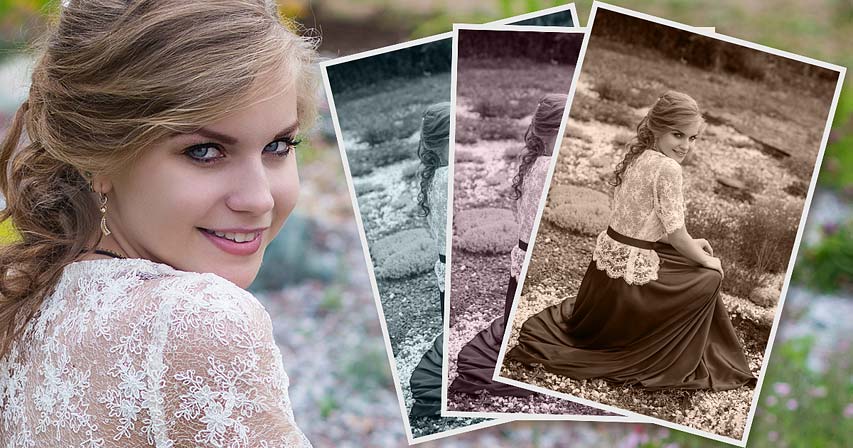
Acquire an easy style to catechumen a full colour photo to a single color with this uncomplicated monochromatic color outcome in Photoshop! A step-by-step tutorial for Photoshop 2021 and earlier!
In this tutorial, I show you a fast and easy mode to add a monochromatic color upshot to an paradigm with Photoshop. The term monochromatic means that the colors in the image are limited to different shades of the same hue, or the same primary
color. And this is a great way to simplify an image or convey a certain mood or emotion. Black and white photography is monochromatic since it uses only shades of greyness, just whatever colour can work.
We'll start past going pace-by-step through the basics of how to convert your image to monochromatic color using a Solid Colour fill up layer, which is the easiest way to do it. And so we'll learn how to combine some of the steps to create the issue even faster. From there, we'll look at a variation of the result that mixes a single color with the photo'due south original colors to create a unified colour theme. And finally, I'll show you the trick to choosing your color directly from the image itself.
I'm using Photoshop 2021 but whatsoever recent version volition work.
Y'all can follow along by opening any image into Photoshop. I'll employ this image from Adobe Stock:
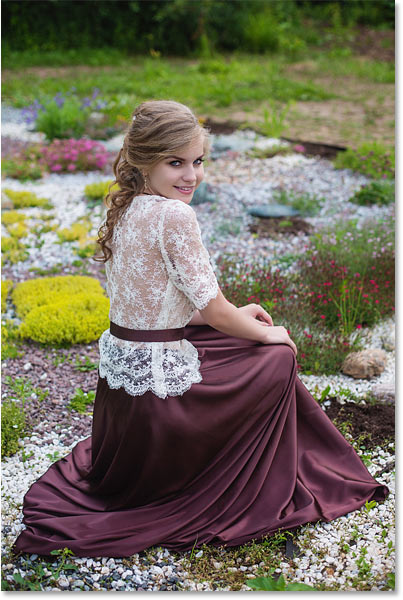
The original photo. Credit: Adobe Stock.
Here is just one instance of the monochromatic consequence, using a sepia tone to give the photograph a vintage await. Other colors can be used depending on the subject field and the mood you lot desire to achieve:
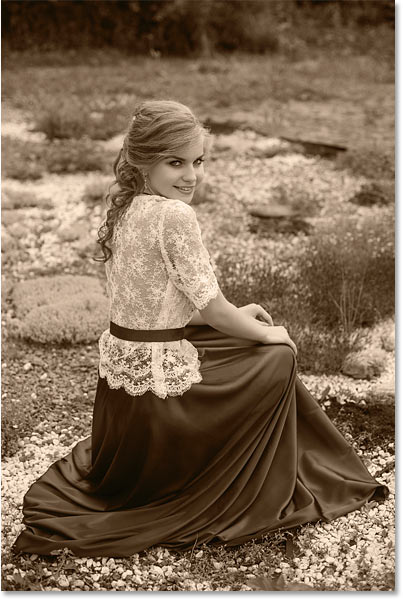
The monochromatic color issue.
And hither's the variation of the event with the sepia tone mixing with the photograph's original colors to unify and alloy all the colors together:

The new color blended with the original colors.
Let'southward get started!
How to convert a photograph to monochromatic colour
Here's how to create the bones monochromatic colour event. Once we've learned how it works, I'll show you how to combine a few of the steps to speed things up.
Footstep 1: Add a Solid Color make full layer above the image
The easiest fashion to convert an image to monochromatic color is by using a Solid Color fill layer.
In the Layers panel, the original photo appears on the Background layer. Add a Solid Color fill layer above the epitome by clicking the New Fill up or Adjustment Layer icon:
Clicking the New Fill up or Aligning Layer icon.
And choosing Solid Colour from the listing:
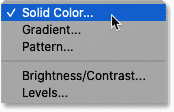
Choosing Solid Colour.
Footstep ii: Choose a main color from the Color Picker
The Color Picker opens, and the image is temporarily blocked by whichever colour is currently selected.
By default, information technology'south black:
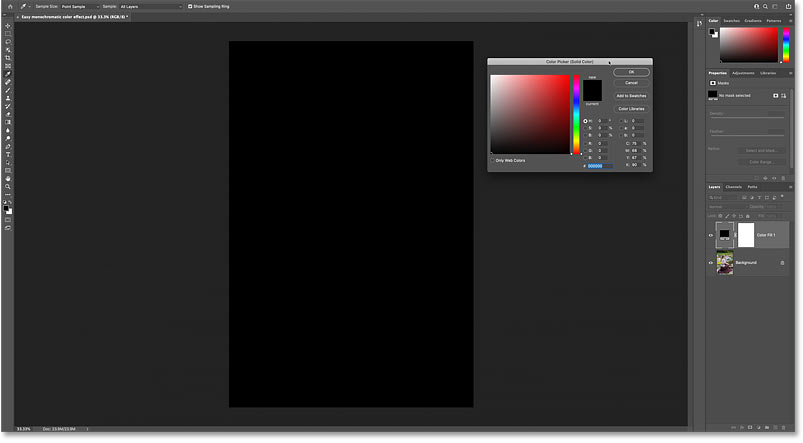
The selected colour in the Color Picker blocks the image from view.
In the Color Picker, cull the colour you want to use. At this point, we but need the hue (the main color). We'll come dorsum and conform the saturation and effulgence in a moment.
I'll choose a ruddy-pinkish:
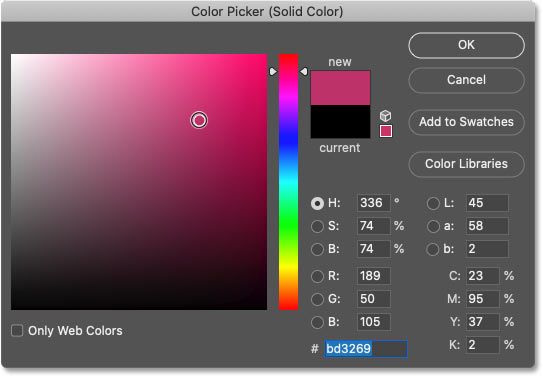
Choosing a new color from the Colour Picker.
Click OK to shut the Colour Picker, and now the new colour blocks the epitome:
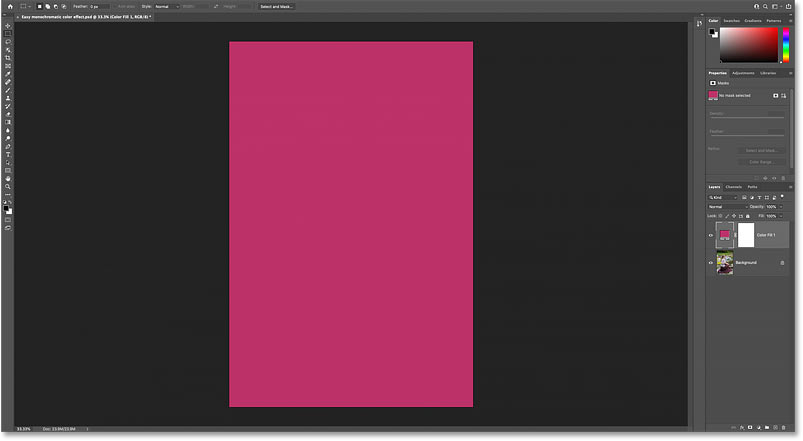
The color is selected, but the image is even so blocked.
Pace iii: Change the fill layer's alloy fashion to Color
Back in the Layers console, the Solid Color fill layer sits above the Background layer.
To blend the color from the fill layer with the prototype beneath information technology, change the fill layer's blend style from Normal to Color:
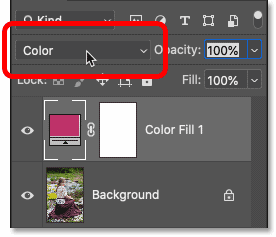
Changing the blend mode to Color.
The Color blend mode keeps the tonal (brightness) values of the image below but replaces the original colors with the color from the make full layer, creating the initial effect:
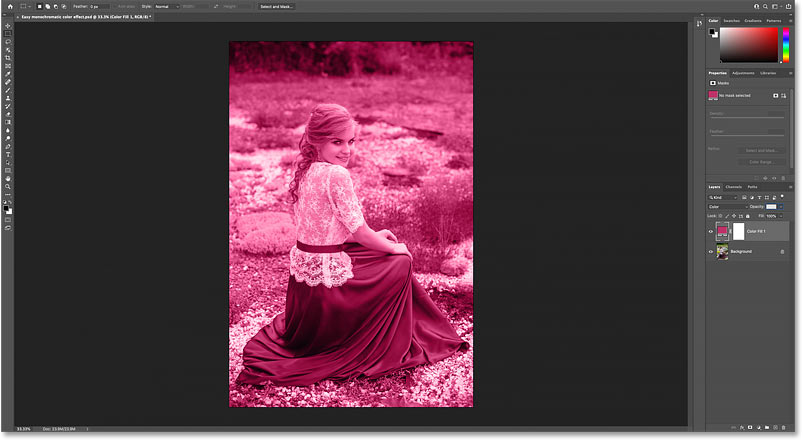
The result after changing the fill layer'south alloy mode to Colour.
Go my Complete Guide to Layer Blend Modes in Photoshop!
Step 4: Re-open the Color Picker
The but problem, at to the lowest degree in my instance, is that the saturation of the colour is also stiff, and it's also too vivid.
To fix that, re-open the Color Picker by double-clicking the fill up layer's colour swatch in the Layers panel:
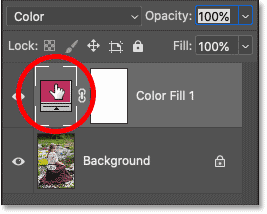
Double-clicking the fill layer'due south color swatch.
Stride 5: Adjust the color'due south saturation and brightness
And so adapt the saturation and brightness as needed.
I'll lower the Saturation (the Due south value) to xxx percent and the Brightness (the B value) to 40 percent. Click OK when you're done:
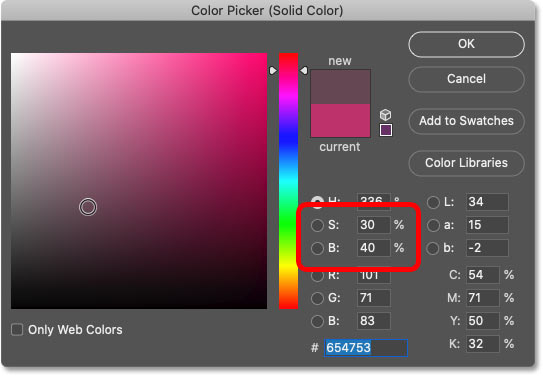
Lowering the saturation and effulgence of the colour.
And with the saturation and brightness lowered, the effect is much more than subtle:
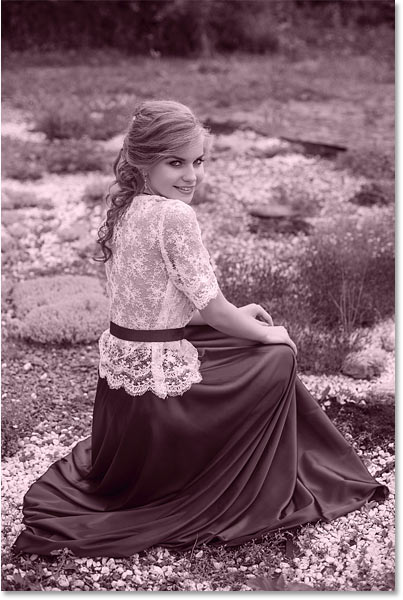
Lowering the saturation and effulgence of the color.
In the Layers panel, you lot tin toggle the effect on and off to compare it with the original photo past clicking the fill up layer's visibility icon:
Utilize the visibility icon to turn the upshot on and off.
And that's the basics of how to convert an paradigm to monochromatic color using a Solid Color fill layer in Photoshop!
A faster way to create the monochromatic color effect
So at present that nosotros know how it works, here'south how to combine a few steps and create the monochromatic colour effect even faster!
Before we continue, I'll delete my fill layer by dragging it down onto the trash bin:
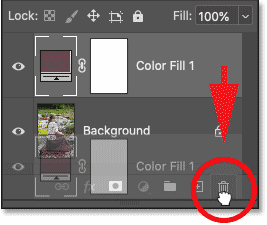
Dragging the fill up layer into the trash.
And now I'1000 back to the original paradigm:
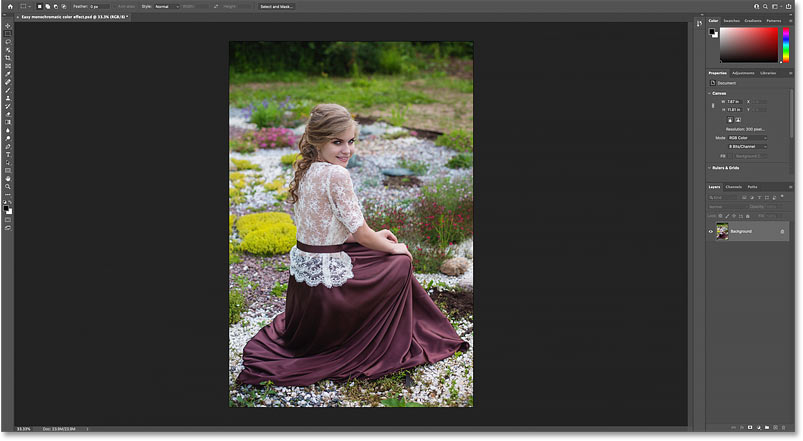
The original photo returns.
Stride ane: Become to Layer > New Make full Layer > Solid Color
Instead of adding a Solid Color fill up layer from the Layers panel, a better way is to get up to the Layer carte in the Carte Bar, choose New Fill Layer, and then choose Solid Color:

Going to Layer > New Make full Layer > Solid Color.
Step two: Gear up the Mode to Color
The reason it'due south better is because this time, Photoshop first opens the New Layer dialog box. And from here, we can alter the blend mode of the fill up layer earlier it'southward added.
Change the Mode (curt for Blend Mode) option from Normal to Color:
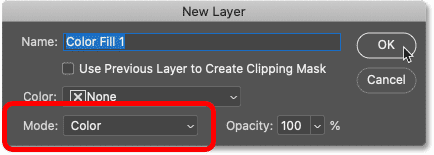
Irresolute the Style to Colour.
Step 3: Cull a color from the Color Picker
And so click OK to close the dialog box, and the Solid Color fill layer appears higher up the image, just like before. But this time, because Photoshop automatically fix the blend manner to Color, the fill layer is not blocking the prototype from view. Instead, the color and the epitome are already blending together.
Since the default color is black, the initial consequence is a black and white effect:
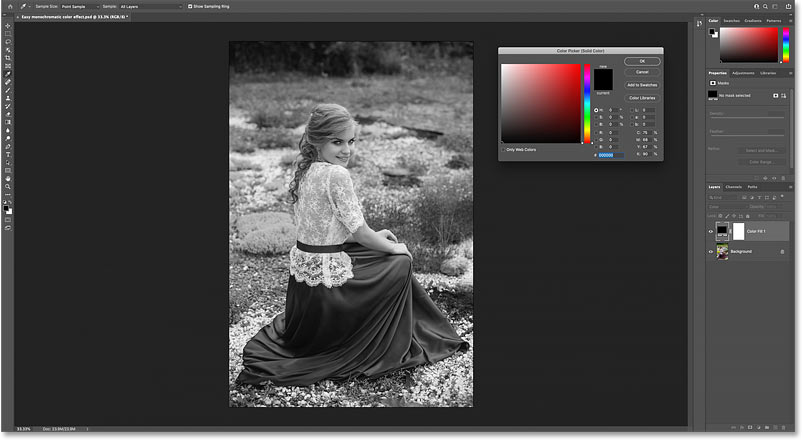
Choosing black equally the fill color converts the image to blackness and white.
Just y'all tin choose whatever color you like from the Colour Picker. I'll go with a sepia tone this time by setting the Hue (H) to thirty degrees, the Saturation (S) to 40 percent and the Brightness (B) to 45 percent:
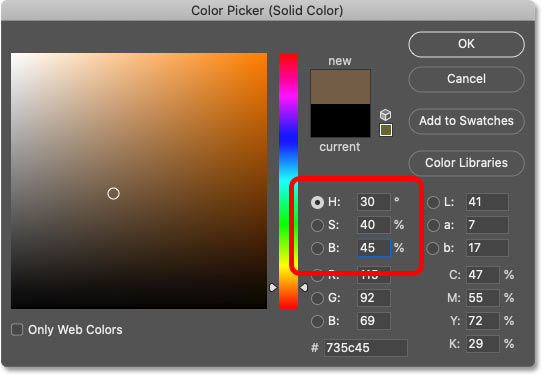
Choosing sepia from the Colour Picker.
Click OK to close the Color Picker, and here's the event:

A sepia tone monochromatic effect.
Variation: How to unify the colors in an paradigm
Instead of creating a true monochromatic effect past replacing the original prototype colors completely, nosotros can also only mix the new colour in with the originals. This is a great fashion to simplify an image and create a unified color theme, particularly when the original colors are also different and distracting.
In the Layers panel, but lower the opacity of the Solid Color fill layer. The more yous lower the opacity below 100 percentage, the more than the original image colors will show through.
I'll lower mine to 60 percentage:
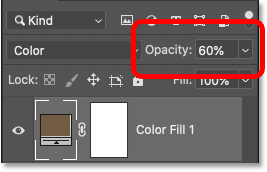
Lowering the opacity of the Solid Color fill layer.
With the opacity lowered, the fill up layer's color is mixing with the original prototype colors and blending everything together.
For comparison, the original photo is on the left and the composite version is on the right:
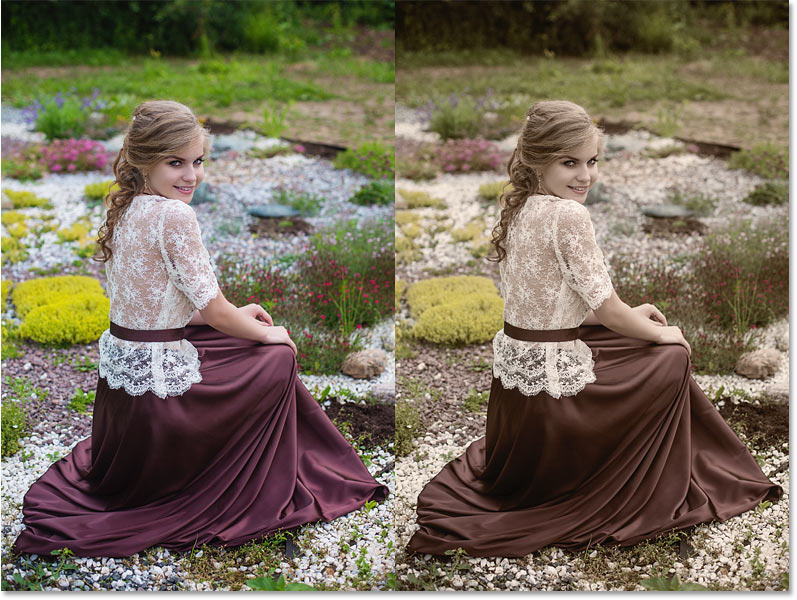
The original colors (left) and the result afterward blending in the Solid Color fill layer (correct).
How to choose a monochromatic colour from the image
Finally, instead of choosing a color for your monochromatic effect from the Colour Picker, what if you desire to cull one from the image itself? Hither'southward how to practice it.
First, in the Layers console, I'll drag my existing Solid Color fill layer down onto the trash bin so I'm starting once again with the original image:
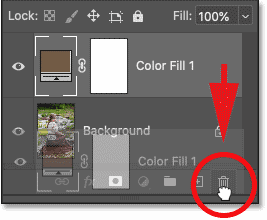
Deleting the existing fill up layer.
Step 1: Click the Foreground Colour swatch
You may have noticed that every time nosotros added a Solid Color fill layer, the Color Picker was initially set to black. That's because the Color Picker was using Photoshop's current Foreground color, which is black past default.
To change the colour, click on the Foreground color swatch in the toolbar:

Clicking the Foreground color swatch.
Stride ii: Click on a color in the image to sample it
When the Color Picker appears, move your mouse cursor over the image and click on a colour to sample it.
I'll sample a skin tone past clicking on the woman's cheek:
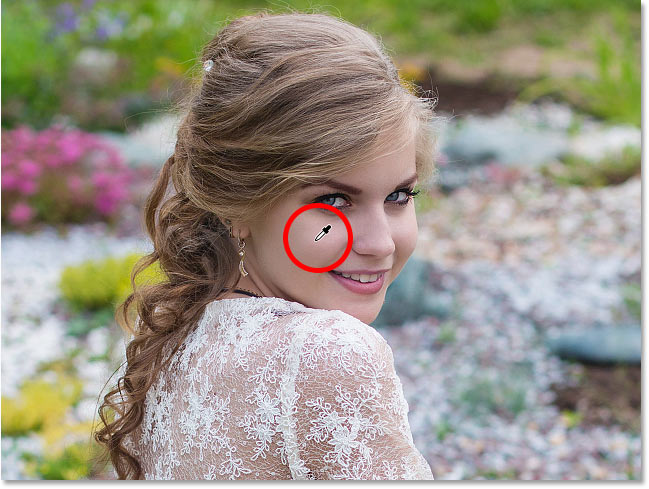
Sampling a color from the image to use for the consequence.
Click OK to close the Color Picker, and now the sampled color has get our new Foreground colour:

The new Foreground color.
Related: How to create color swatches from images in Photoshop
Pace three: Go to Layer > New Fill up Layer > Solid Color
Add a Solid Color fill layer by going upwardly to the Layer card, choosing New Fill Layer and and so Solid Color:

Going to Layer > New Fill up Layer > Solid Colour.
Footstep 4: Fix the Mode to Colour
In the New Layer dialog box, modify the blend mode to Color:

Changing the Mode to Color.
Then click OK, and the original colors are replaced with the sampled color from the paradigm:
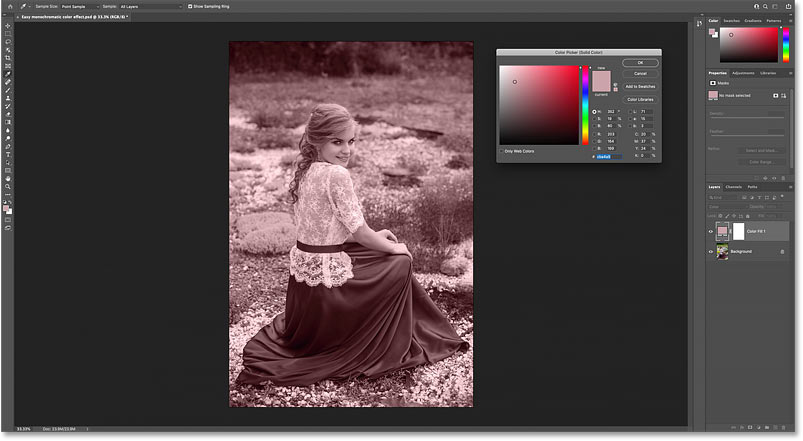
The colors are replaced with the sampled colour.
Step 5: Adjust the brightness and saturation in the Color Picker
Before closing the Color Picker, adjust the color's saturation and brightness if needed. I'll lower both to 30 percent:
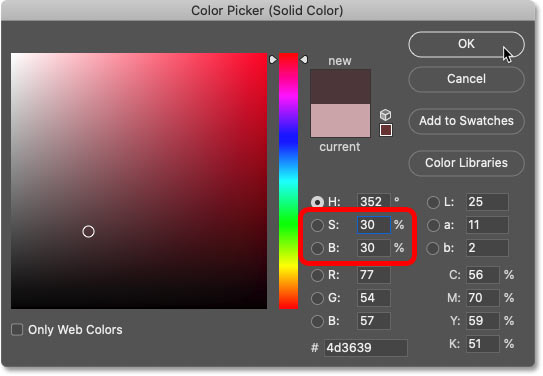
Lowering the saturation and brightness of the sampled color.
Then click OK, and here's the result:
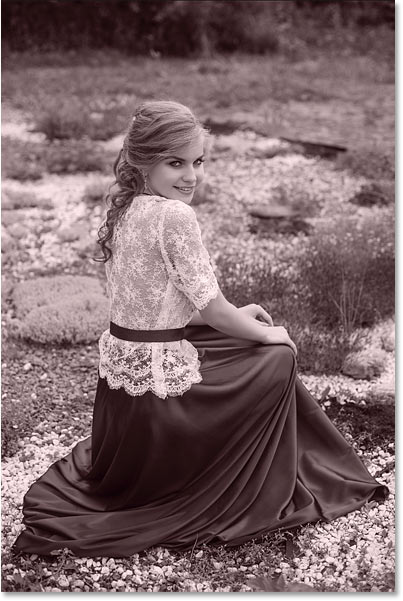
The monochromatic event using the sampled color.
Footstep half-dozen: Lower the fill layer's opacity (optional)
Of course, you can besides lower the opacity of the make full layer to blend the sampled color with the balance of the colors in the image.
I'll lower the opacity to 50 percent:
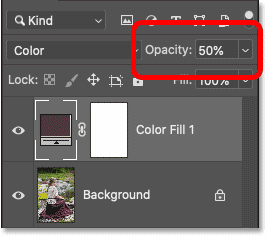
Lowering the fill layer's opacity.
And here's my terminal result:
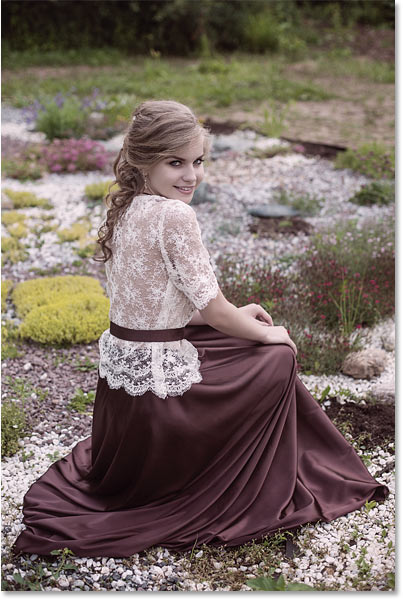
The sampled color is unifying all colors in the image.
Where to go adjacent...
And in that location nosotros have it! That'due south how easy information technology is to add together a monochromatic color event to an prototype with Photoshop!
Visit my Photo Effects section for more tutorial ideas. And don't forget, all of my tutorials are available to download equally PDFs!
Other Stuff
© 2022 Photoshop Essentials.com.
For inspiration, non duplication.
Site design by Steve Patterson.
Photoshop is a trademark of Adobe Systems Inc.
Source: https://www.photoshopessentials.com/photo-effects/how-to-create-a-monochromatic-color-effect-in-photoshop/
Posted by: blouinorden1951.blogspot.com

0 Response to "How To Make A Picture Monochrome In Paint"
Post a Comment